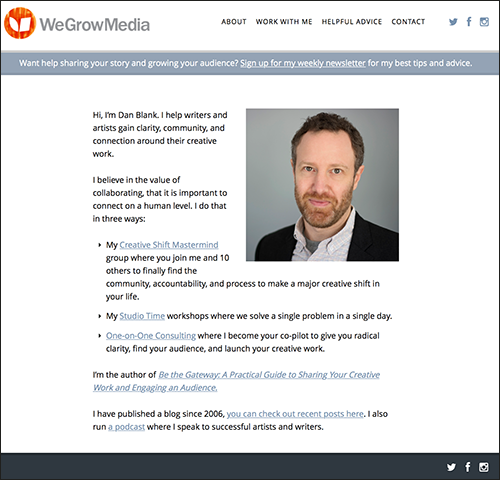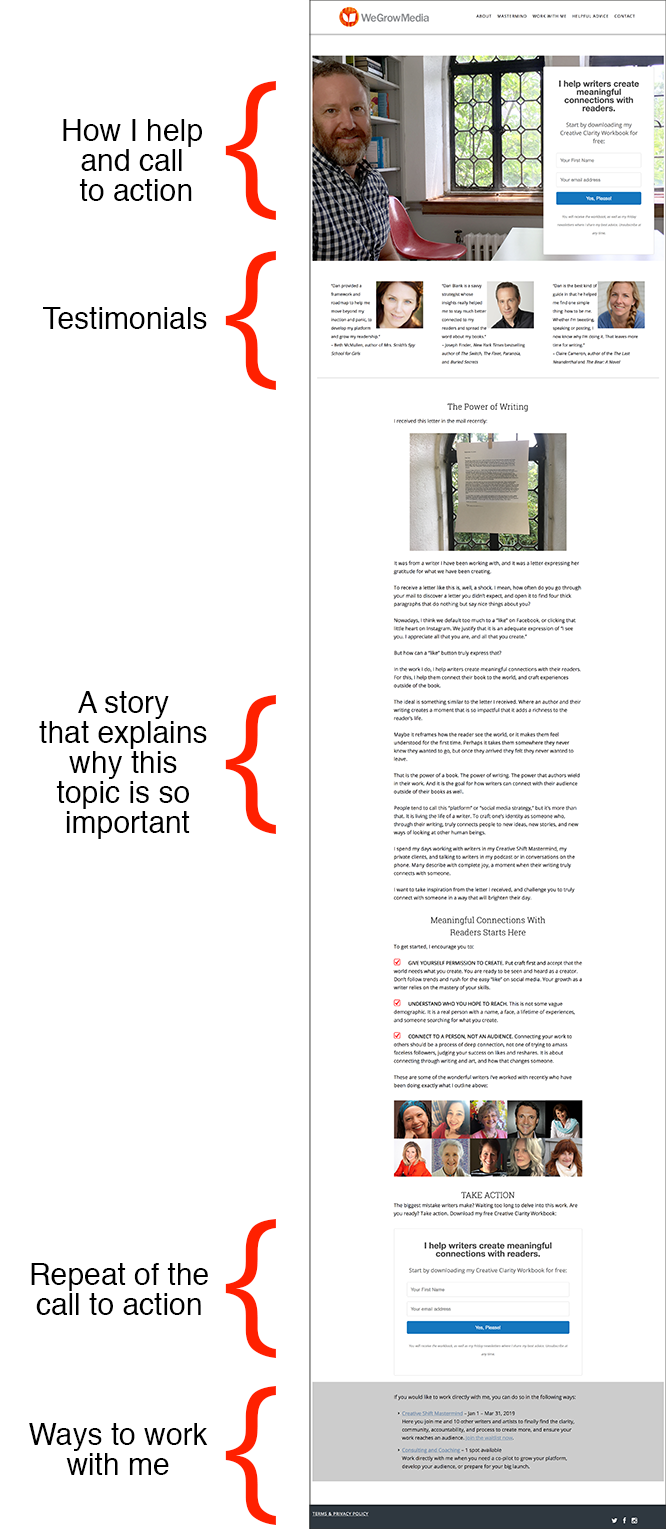Today I want to share some tips on how to create a website that feels authentic to who you are as a writer or artist:
Step #1: Understand Your Goals
Earlier this year I was having a conversation with a writer in my Creative Shift Mastermind about options for a website homepage. I explained a key choice:
- You can have your blog posts as your homepage, a listing of your most recent entries. The value here is that you highlight your blog, and it features your most recent content. This is nice because you engage people immediately with your writing.
- Or, you can have a landing page, which is a homepage that clearly explains who you are and what you create, and tries to lead the reader to take a specific action.
At the time, my homepage had contained mostly my blog posts. I had it this way for more than a decade.
As this writer and I went back and forth, I ended up convincing myself that I was long overdue to change my homepage to a proper landing page. After all, every single day my goal is to help writers forge meaningful connections with readers. Couldn’t I do that more effectively if my homepage provided resources to do this instead of whatever my most recent blog post was?
Step #2: “Good Enough” is a Fine Way to Start
Within 24 hours of that conversation with the writer in my Mastermind, I switched my homepage to a landing page. It felt scary, like I was trying on not just a new outfit, but a whole new style. I was afraid it didn’t fit right, and didn’t suit my personality.
I started with a “good enough” homepage. I described who I was, and how I helped writers. I referenced some recent blog posts too, since I wasn’t fully ready to hide those. Looking back on it now, it looks really simple:

Then I made it better. I think these are some of the essential elements of a good landing page:
- A clear statement of what you do or how you help.
- Something human — a photo of you, or anything that communicates that you are a real person, not a stock website template.
- It should lead to one clear action or resource for the viewer to follow. This is what a lot of people refer to as a “call to action.” Usually it is to purchase your book or join your email list, but it could be many other things.
- Testimonials or reviews of your work.
- A deeper look at why you do what you do. Don’t just sell something, explain why it matters.
This first version was “good enough,” but it felt a little flat. Like you are staring at a menu board of all of these amazing milkshake flavors, and then you choose “vanilla.” I don’t want my creative work to be vanilla.
Step #3: Create a Radical Fake Homepage
I was chatting with my friend Jennie Nash about this, and we created a prompt to break free of the vanilla website. I told her I would send her a document that was radically honest about who I am and what I do.
I ended up calling this my “Radical Fake Homepage.” I used that as a safe prompt in order to create something that felt authentic and engaging. The idea was to be really honest — to not edit myself at all. “Radical.” But keep it safe by calling it “Fake” — I didn’t feel pressure to actually make this the real homepage.
Once I put it down on paper and shared it with her, a question quickly emerged: “Why isn’t this radical page your real page?”
The radical homepage was just so honest about why I love working with writers.
This was in April. Looking back at my archived notes, it seems I began the first version of the Radical Fake Homepage on April 27th. I then created four iterations of that document, and just three days later, I made this fake homepage my real homepage.
The result: it felt like the homepage truly reflected who I am, what drives me, and how my time is spent helping writers.
Step #4: Constant Experimentation and Improvement
I have since gone in, again and again, and updated the homepage. Sometimes I honed it with little edits. But other times, I completely — and dramatically changed it. I tried out new taglines, new images, new colors, new layouts. This is how the homepage looks right now:

I have also been experimenting with the free resource that you receive when you sign up for my newsletter list. One of them has been a “Creative Clarity Workbook.” Another that I am now preparing to launch is called “5 Ways to Immediately Connect With Readers.” (more on that soon.)
With each new change to the homepage, I feel clearer about the work I do and how I can more effectively communicate with writers.
For your writing and creative work, consider how your homepage can most effectively do this in a way that feels authentic to who you are, and create a meaningful connection with readers.
Below are a few links to previous posts I have written about redesigning my website. The advice in these older posts still holds true:
Thanks!
-Dan
